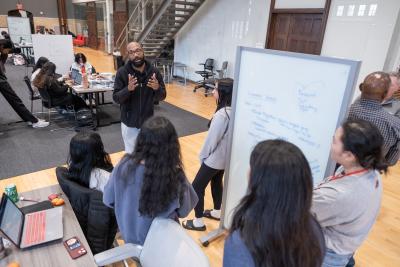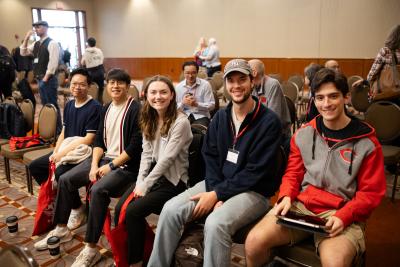Redesign of Undergraduate Courses and New Major
A major change in the format of the Department’s large multi-lecture undergraduate service courses took place during the period 1999-2024. In 2000, the Statistics Department taught three large multi-lecture undergraduate service courses. These were Statistics 135 (intended for students in the Humanities and now 1350), Statistics 133 (intended for Business students and now 1430), and Statistics 145 (intended for students in the Social Sciences and now 1450). Each course involved several large lectures taught by faculty or senior graduate students and several small (25-50 student) labs taught by graduate teaching assistants. A faculty member coordinated the course content, common exams, grading, course material, and supervision of graduate teaching assistants. To ensure the consistency and quality of course material, the Statistics Department hired several full-time faculty teaching specialists to coordinate these courses. The first specialist hired was Roger Woodard in 1999. In 2003 Jack Miller, was hired and became the coordinator of Statistics 145. In 2004 Deborah Rumsey was hired to be the Director of the Mathematics and Statistics Learning Center (MSLC) and began coordinating Statistics 133.
Funded by a Pew grant in 2002, the Department redesigned the undergraduate course Statistics 135. Professor Dennis Pearl was instrumental in creating and managing a “Statistics Buffet” strategy with interchangeable paths –lecture, video, group solving sessions, and group projects. This redesigned course was named a finalist in the Computer World honors program as one of the top seven (worldwide) uses of technology in education. Dennis Pearl continued to coordinate Statistics 135 until 2014 when Michelle Everson was hired to coordinate the course. In 2013, Jack Miller left Ohio State to take a position at the University of Michigan and Jonathan Baker was hired to coordinate Statistics 145. In addition to these teaching specialists, the Department began to hire part-time lecturers to assist in teaching some of the large lectures in these courses.
In 2006, the Department introduced two new undergraduate honors courses, one (Statistics 133H) for Business majors and the other (Statistics 246H) for students who completed Statistics 245. The Department also introduced a new undergraduate sequence for actuarial science students and a new initiative for an interdisciplinary undergraduate minor program in survey sampling, which involves a new undergraduate survey methodology course.
Although, the Department had offered an undergraduate minor in Statistics for many years, it was lacking an undergraduate major. This was rectified in 2018 when the Department began development of a new Undergraduate Major in Statistics which was fully implemented in 2022.
New Degree Program in Data Analytics

In 2014, the Statistics Department and Department of Computer Science and Engineering jointly launched the undergraduate major in Data Analytics. This was the result of a university sponsored initiative in data analytics. The major has five specializations: Biomedical and Public Health Analytics, Business Analytics, Computational Analytics, Data Visualization, and Social Science Analytics. Chris Hans (Statistics) and Srinivasan Parthasarathy (Computer Science and Engineering) were the initial co-directors for the major, and continued until Tom Metzger succeeded Hans as co-director. Every year since 2016, the Department has demonstrated the strength of the Data Analysis major by participating in the Data Analytics contest Data Fest. Data Fest is sponsored by the American Statistical Association and hosted by several of the most prestigious colleges and universities in the country.
Graduate Programs
At the graduate level, the Statistics Program and its exam structure has been revisited and updated every few years to reflect changes in the field. A Master of Statistics (MS), a PhD in Statistics, and a PhD in Biostatistics have all been offered since the founding of the Department. The Master of Applied Statistics (MAS) was added to the offerings later. This was a very popular program both within the Statistics Department and for students external to the Department. In the early 2000s, the MAS program was regularly graduating up to 50 students annually. The Department has regularly held research reading groups and research-level courses for graduate students, often under the course number 8750, covering topics such as statistical genetics, ranked-set sampling, Bayesian statistics, computer experiments, network analysis, spatial statistics, clinical trials, statistical learning and data mining.
In 2002 the Department developed a one-of-a-kind PhD degree in Statistics Education. In 2006 the Graduate School approved our two Graduate Minors, one in Statistics and one in Statistical Data Analysis. Throughout the 2000s, the Department continued to provide graduate students in other disciplines with degree opportunities through its MAS and its two Graduate Minor programs.

A Graduate Interdisciplinary Specialization (GIS) program was instituted by Ohio State in the early 2000s. In Spring Quarter 2000, a GIS in Survey Research was approved by the university, with courses offered by Agricultural Education, Economics, Educational Policy, Geography, Journalism, Marketing, Political Science, Psychology, Public Health, Sociology, and Statistics, among others. The department was also involved in proposing and administrating the GIS in Geospatial Data and Analysis with the Department of Geography; this ran from 2006 to 2018. In 2009, a GIS in Quantitative Methods in Consumer Behavior was also approved and ran for a decade; it was jointly proposed and administered by the Departments of Statistics, Psychology, and Marketing. Unfortunately, the implementation of a new university rule limiting post-candidacy coursework eventually reduced interest in the GIS programs as well as the Department’s external MAS program.
The Move from Quarters to Semesters
In the 2012-13 academic year, the Ohio State University (OSU) officially converted from quarters to semesters. This was a major undertaking, requiring a huge amount of time, planning, discussion and paperwork from the entire faculty and staff. Existing courses, course sequences, and degree requirements all had to be modified as part of the conversion. The schedule had to be completely re-thought. All course numbers were changed. For example, Statistics 135 and 620 became Statistics 1350 and 6801, respectively.
Covid Disruption
In March 2020, COVID-19 was declared a pandemic and caused severe disruptions around the world. Over spring break in 2020, university mandates to led to the elimination of in-person classes and instructors had to switch to online classes immediately after this spring break. To prepare for fall semester 2020, the university asked faculty to create online versions of courses and provided guidelines for what these courses should look like. This required a considerable amount of initial effort but did leave the Department with online versions of courses and resources.
Educational Materials and Conferences
The Department has been active in Statistics Education at the local, national, and international level throughout its history. Bill Notz, Dennis Pearl, and Elizabeth Stasny were involved in the EESEE (Electronic Encyclopedia of Statistical Examples and Exercises) project from 1998-2013. They developed an electronic resource containing data sets from real applications of statistics along with the background story behind the data and suggested exercises based on these data.
In 2002, Dennis Pearl and Deb Rumsey helped found the CAUSE organization (the Consortium for the Advancement of Undergraduate Statistics Education), with Pearl serving as its Director from 2002-2024. In August 2004, www.CAUSEweb.org went live, providing an extensive digital library of resources for statistics instructors as part of the National Science Digital Library system funded by NSF. CAUSEweb now contains more than 1500 items in the resources collection, more than 2100 items in the statistics-education research literature collection, dozens of items formally reviewed for content quality, effectiveness for teaching, and ease of use, and hundreds of items providing services or miscellaneous enhancements to community members. CAUSE also sponsors national and international conferences (eg. USCOTS, see Table 9).
The Department has produced two editors of the Journal of Statistics and Data Science Education; Bill Notz (2007-2009) and Michelle Everson (2013-2015). In addition, Jean Scott has served as the Editorial Coordinator for the journal since 2007.
Department faculty have authored a number of popular undergraduate statistics textbooks as well as many graduate level books in the last 25 years, including those in Table 4.
